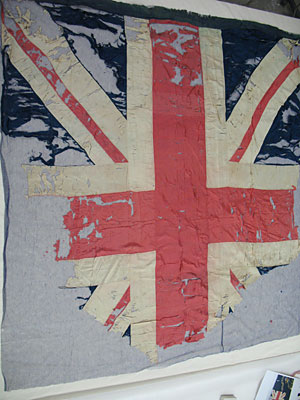History through textiles and technology
June 26, 2010
We all know how the passage of time can cause irreparable damage to a delicate garment – yellowing, fraying, staining. So imagine the challenge of restoring flags dating back to the early 19th century. But when technology is put to use by dedicated workers like Julie Hughes, Textile Conservator and Megan Gruchy, Assistant Conservator at the Canadian Museum of Civilization Corporation, tattered flags are given the chance to regain their youthful splendour.
When history hangs by a thread …
In 1838, the Patriot Rebellion was in its final confrontations with the battles of Lacolle and Odelltown. Alongside the British Regulars fought the Hemmingford Loyal Volunteers, a military unit from Lower Canada led by Major John Scriver.
In recognition of their contribution to combat, the ladies of Hemmingford presented to the militia unit a hand-made regimental colour (flag). The family of Major Scriver conserved the flag until eventually bestowing it to the Canadian Historical Society, who gave it to the Canadian War Museum in 2003.
The relic did not arrive in great shape; a whole section was reduced to shreds. But the value of its restoration was not lost on anyone – in addition to representing an early 19th century militia unit, it is one of the first flags to bear the monogram of Queen Victoria, who ascended the throne in 1837. And so began a painstaking task …
An UV makeover
Ever in search of modern, cost-effective, quick, and safe techniques, Julie and Megan embarked on a new adventure – testing the digital printing of UV ink onto silk crepeline.
The restoration of an artifact such as this requires a number of steps. First, the flag – or what was left of it – had to be fitted onto a silk fabric base of its original dimensions and colours; photography then allowed the numbering of sections that had survived the ravages of time and the reproduction of missing parts. A delicate silk transparency of the same size – the crepeline – was then secured to a flat frame onto which the design was reproduced in UV ink. The crepeline was then laid atop the flag and expertly sewn into place. Finally, the piece was stabilized under a Plexiglas plate for its long-term protection.
Until only recently, crepelines had to be sent to California for treatment like this – a costly, lengthy, and risky step in the restoration process. Julie and Megan’s research, however, led to an Ottawa printer who offers an even more innovative service. Instead of sliding through printing rollers, crepeline is laid flat on a printing table – this allows for a more precise reproduction without distortion and a speedier drying time.
Three hundred hours later, the results are not only conclusive, but extremely impressive. So much so that Canadian and international institutions have taken notice. Buoyed by this success, Julie and Megan have now thrown themselves into the restoration of another flag related to the Hemmingford Loyal Volunteers – a Union Jack that will soon find itself back at high mast.




The restoration of the Hemmingford Loyal Volunteers flags was made possible thanks to the support of the Friends of the Canadian War Museum. Wouldn’t you like to save a piece of history? Large or small, your donations can help preserve our national heritage. Click here to make a donation.